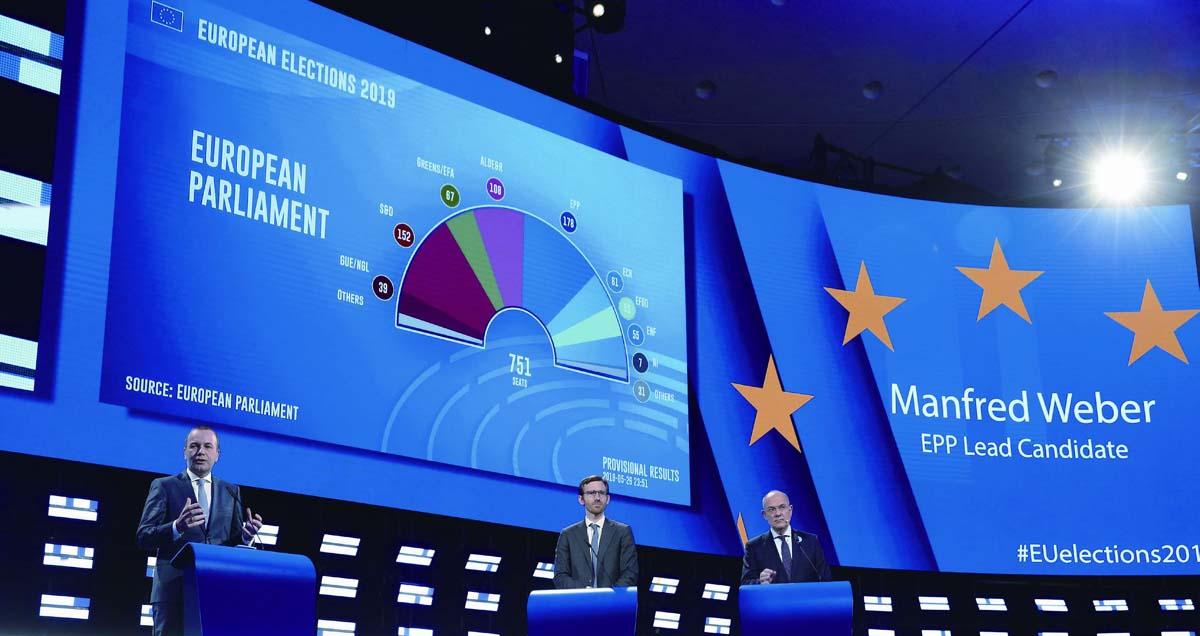Precarious Times
2019-09-09ByZhangLei
By Zhang Lei

This years European Parliament election faced much higher political risks, as the European Union (EU) is in the midst of both internal and external diffi culties. From May 23 to 26, the 28 EU member countries voted in what was viewed as a duel between mainstream political parties and populist parties, with the latter making some advances, but not as much as predicted.
Made up of 751 members, the parliament held its ninth election since 1979, when direct elections were fi rst adopted on a fi ve-year basis. Voter turnout surpassed 50 percent, reversing the past declining rate.
As the representative of 500 million EU citizens, the European Parliament is more signifi cant than ever and its increasing power will enable the organ to play a more vital role in the EUs legislation and future. One reason for the wide attention given to this election was that many believe its results will be closely related to the selection of the new president of the European Commission.
Party patterns
Overall, the results of the election did not exceed expectations and continued the current trend of political party development in Europe.
Center-right and center-left mainstream parties were challenged, losing some seats. In many member countries, this election was regarded as the touchstone of local or national elections. Citizens voted as a way of expressing support for or dissatisfaction with their current governments, causing mainstream parties to lose votes. As of June 4, the European Peoples Party (EPP) and the Progressive Alliance of Socialists and Democrats (S&D), the two largest political groups in the EU, secured 179 and 153 seats respectively. For the first time in the parliaments history, the two major political groups were unable to garner 50 percent of the seats as the gap between big and small political groups was narrowed.
The pattern of European political parties has become more decentralized and fragmented in recent years, while the populist forces have continued to rise. The Brexit Party took 31.71 percent of the vote and was the winner in the UK, gaining more seats than the Labor and Conservative parties combined. The League in Italy and the French National Rally gained 33.64 percent and 23.54 percent, respectively, ranking number one in their respective countries. The Five Star Movement from Italy got 16.65 percent and the Alternative for Germany gained 10.8 percent. Moreover, some populist parties won seats for the fi rst time. However, due to the instability in policies and ideology, it is still not clear how or if populist parties will work together.
The Group of the Alliance of Liberals and Democrats for Europe (ALDE) and the Group of the Greens, a party coalition focusing on environmental issues, gained more strength, winning 105 seats and 74 seats, respectively. République en Marche, led by French President Emmanuel Macron, entered the parliament for the first time and joined the ALDE, which boosted the groups number of seats. The German Green Party won 22 percent of the vote, second only to German Chancellor Angela Merkels Christian Democrats. The Greens also saw gains in France, the Netherlands, Ireland, Belgium and other member states.
From a panoramic view, the pattern of political parties in the European Parliament was more fragmented, which coincided with the overall political development trend across Europe. Traditional big parties no longer exist; instead, a new political system consists of a combination of two or three medium-size parties along with three to five small ones. This multi-party system is increasingly flexible, as the integration of and splits in political parties proceed simultaneously.
Reasons and background
Votes were scattered rather than concentrated in this election, resulting in the decline of big parties and the surge of small ones, which to some extent reflected a divided EU society. The populist parties emerged as a result of changes in EU politics, economy and society.
The strain between the market and society offered a basis for the advancement of populist forces. To cope with economic globalization, EU member countries hoped to form a new border through regional integration to protect themselves and strike a balance between society and the economy. However, it turned out that political power and social progress cannot stop the progressively expanding market.
Against such a backdrop, one option put forth by ultra-right forces is the reinforcement of borders to stop the influx of immigrants. More people, egged on by these nationalist forces, are blaming immigrants for social problems such as unemployment, high criminal rates and moral decline. Support for populist parties will continue as the EU economic slump, the pains of structural reforms, the refugee crisis and the threat of terrorism persist.
Another option that has emerged is to reject the EUs austerity policy, arguing that it exacerbated member states economic diffi culties and burdened their welfare systems. Thus, more voters have begun to turn to leftwing parties.
The political platforms and policies of the traditional center-left and center-right parties have become increasingly similar, leaving political space for the emergence of other parties. Traditional parties that were supposed to express the will of the voters were institutionalized as part of the system, losing their connection with their constituents and drifting away from voters.

Many people lost trust in traditional parties to represent their interests. Meanwhile, populist parties exploited the wedge between common people and elites and won support through demagogic slogans. For instance, the ultra-right League in Italy argued that Italian culture was being destroyed and it was a must to safeguard the national traditions and cultures of every region. The party argued that immigrants in Italy should assimilate, saying that such a policy is an effective way to avoid frictions and protect personal safety.
Populists, in a sensationalist way, raise many issues of concern to voters, which are the weak links in mainstream parties. The surge of populist parties is the result of the European political pattern and is set to pose new challenges to the latter.
Future impact
Nevertheless, the EPP, the S&D, the ALDE and the Greens, all supporting EU integration, accounted for the majority in the newly elected legislature.
In the decision-making process of the European Parliament, different procedures require different parliamentary majorities. No political group reached a simple majority on its own, let alone an absolute majority. Therefore, they will have to form alliances to pass their proposals. Currently, there are no fixed alliances in the parliament, since parties form different alliances based on policy areas.
What can be anticipated is that the EPP and the S&D may possibly work together more, especially when confronted with populist parties. The ALDE may sometimes join this alliance. However, due to the fragmentation of its party structure, the newly elected parliament will face increased uncertainty in the future. For instance, EU reform will be more challenging as the centerright EPP is inclined to austerity plans, while the center-left S&D supports stimulating growth. In terms of trade, negotiations on the Transatlantic Trade and Investment Partnership with the U.S. are more difficult. The ALDEs status as a kingmaker will be further consolidated and it will be expected to play a vital role in the appointment of the new European Commission president.
Although populist parties gained more seats, there are many restrictions on their actual impact. They differ greatly from each other and so do their ideologies and policy pursuits. The Europe of Nations and Freedom Group, for example, has different views among its own members on many issues such as sanctions against Russia, a single digital market and the development of nuclear energy.
The European Parliaments rules of procedure also limit the role of populist parties or groups, which have often been excluded from alliances by mainstream party groups. As a result, their anti-European integration proposals have been diffi cult to pass.
There should be a cautious attitude toward populist parties. They may cynically dominate public opinion and obstruct the passage of some bills. Moreover, issues of concern to populist parties entered the discourse of major parties and have now become their policy focuses. For example, some mainstream parties have turned more conservative toward immigration issues. The rise of populist parties in the European Parliament is a sign that they have developed into a political force that should not be underestimated in European politics. In the long run, if the populist parties power continues to mount, it will not only impact the political structure of member states but also the EUs political operation.
